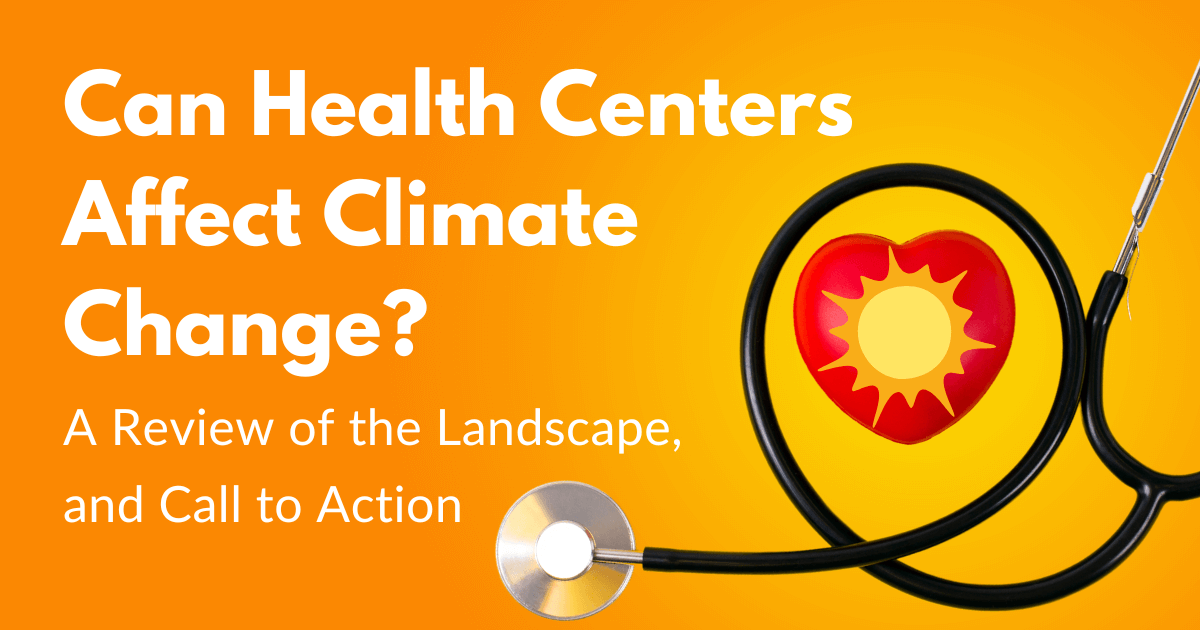Can Health Centers Affect Climate Change? A Review of the Landscape, and Call to Action

Last month in Yuma, Arizona, 26-year-old farmworker and father of two, Dario Mendoza, died after collapsing twice and suffering heat stroke while working. Yuma experienced temperatures above 100 degrees Fahrenheit for a record 67 days in a row this summer, but the break in temperatures didn’t last. Today’s high in Yuma is expected to be 116 degrees. Phoenix has also been burdened with 31 consecutive days of 110+ degrees Fahrenheit temperatures. Arizona’s recent heat wave has caused hospitalizations to reach pandemic levels in several health centers, such as Valleywise Health Medical Center. Emergency room physician Frank LoVecchio at Valleywise told CNN that he has seen three to four cases per shift of patients who were experiencing life-threatening heat stroke. Additionally, patients are frequently coming to emergency rooms suffering from heat-related illnesses and chronic conditions aggravated by the heat, every patient also feeling dehydrated. This is despite the fact that Phoenix has 60 hydration stations, 30 cooling centers, and four respite centers. Moreover, power outages due to malfunctioning equipment and an increased usage of air conditioning and electricity further jeopardize the health of the population.
The climate crisis is here. The world is transitioning to a “new climate frontier,” resulting in stronger wildfires, droughts, and storms, in addition to ongoing record-breaking temperatures. The destructive effects of such climate disasters are already rising in our surrounding communities. For example, there are notable increases in heat-related stress injuries and deaths for workers working outdoors. Eugene Gates, a postal worker in Dallas, and Felipe Pascual, a construction worker in Houston, are both recent examples of victims to heat’s fatal impacts. Heat also increases workplace injuries resulting from reduced cognitive performance and decision-making.
But the climate crisis has health impacts beyond heat. Due to climate change disturbances, more individuals are suffering from respiratory and cardiovascular disease, infectious diseases, and mental health concerns. Oftentimes, such individuals who seek care when they have health problems related to climate are the most disadvantaged and vulnerable, and subject to socioeconomic disparities. Such individuals experience the greatest burden from climate-related health problems.
Studies have shown that communities that are composed of Black, Indigenous, people of color (BIPOC) are the ones that bear the greatest burden of climate crises. For instance, with 3.6 degrees of global warming, it is projected that African American individuals are 40% more likely to reside in regions that will have the highest increase in temperature-related deaths. Furthermore, many individuals of Latin heritage work in weather-exposed industries to make their living, so extreme temperatures will worsen their working conditions and health. Many communities are hesitant and fearful to seek health care, whether because of lack of insurance, prior negative experiences, structural racism, or socioeconomic factors. Few states have standards in place aimed at protecting workers from heat.
Health centers have a moral and professional obligation to support their surrounding communities during climate-related emergencies. Clinicians are tasked with improving the health of their communities, so health centers need to address and respond to the growing climate crisis accordingly. Some key avenues for health centers to address the climate crisis include:
Partnerships: Health centers can take a more personalized and active role in their surrounding communities by expanding on partnerships to both address climate issues and prevent further warming. The National Association of Community Health Centers (NACHC) recommends, among a long list of recommended health center actions, supporting community efforts for projects like providing free air conditioning units and access to clean power to low-income families. This must be targeted specifically for rural and low-income individuals since such populations often do not have easy access to health centers and health care resources.
Funding: Progress and development are happening at the community level – and more funding is opening to support it. For instance, Johnson & Johnson’s $2 million grant designed to support climate health equity at community clinics is a clear example of several positive efforts beginning to develop to raise awareness about the crucial role of community health centers in climate crises in addition to highlighting the relationship between such health centers and their surrounding local communities, especially considering migrant and rural communities.
Preparing for Climate Disaster: To limit the degree of destruction and damage to the community, both infrastructure and health-wise, health centers should collaborate with the community and identify the natural hazard risks of the natural disaster/climate crisis to start preparing resources to reduce its degree of impact. It is also important for health centers to network and collaborate with other regional health centers as well as local government agencies to not only ensure that they have the logistics and supplies to support the likely increased number of patient cases, but also to communicate with the surrounding community about necessary steps and actions they should take before climate crises/disasters instead of coming to the health center directly for aid . Migrant Clinicians Network (MCN) has been heavily involved with climate mobilization and climate justice to assist community health centers in collaborating with key community leaders and support the most vulnerable during climate emergencies. Having conducted over 700 technical assistance and educational encounters since 2018 focusing on climate related-disaster prevention and protecting vulnerable communities, MCN has been able to successfully reach 13,000 individuals in the continental US, Puerto Rico, and the US Virgin Islands. Furthermore, MCN’s efforts in Puerto Rico have been greatly beneficial in raising awareness about the impacts of climate crisis on the agricultural worker community, through partnering with health centers. MCN's Dr. Marysel Pagan Santana and several other MCN staff published an article analyzing the public health factors of the climate crisis on the children of agricultural workers, that resulted from research with medical personnel, parents, and teachers in agricultural communities in Puerto Rico.
Other groups and organizations such as Clinicians for Climate Action and Planetary Health Alliance have also been created to address the role of clinicians and health centers in the climate crisis. For example, Arizona Health Professionals for Climate Action is a group of health professionals who network and collaborate to educate and engage fellow health care workers, health centers, hospitals, and other local organizations about climate action to create a healthier future.
Reducing Environmental and Climate Impact: On a daily basis, health centers are on the frontlines when it comes to responding to emergencies in their communities, so it is of utmost importance that they further this role by examining their collective response to the climate crisis. Hospitals, for example, consume double the water compared to most large buildings, but some health organizations are responding. For example, Stanford Health Care is evaluating its water usage to see how it can reduce usage. Many health centers are transitioning to renewable energy, their solar panels creating needed shade in the parking lot. Some have begun to invest in battery systems to ensure that their solar energy is useable in the case of a power loss. Much of the carbon emissions from the health system, however, are indirect. “Scope 3” emissions from the production and transportation of goods and services needed by health facilities account for more than 80 percent of overall health care emissions.
Next Steps for Health Centers: How can community health centers play an impactful role in climate change and associated climate crises? Investing in renewable energy and sustainable transportation in addition to collaboration efforts with other clinicians and health centers are some ways health centers can tackle this growing crisis. Ohio State University Wexner Medical Center, a hospital, converted to reusable containers for sharps, helping to save 50 tons of plastic annually, as plastic is a byproduct of fossil fuels and a major waterway pollutant; health centers can take similar steps. Health centers and clinicians not only should focus on developing methods to help their communities better respond to climate crises but must also innovate solutions to address their own responses to the climate crisis. Health centers and clinicians must ask themselves: How are they minimizing/reducing their usage of fossil fuels, engaging in community advocacy, and building partnerships with other health centers?
Future Outlook of the Climate Crisis: What will happen if health centers do not act efficiently and on a timely basis? The World Health Organization estimates that health-related conditions arising from climate change will contribute to 250,000 additional deaths per year between 2030 and 2050. Clinicians and health centers have an important role in addressing the climate crisis and helping their communities and patients so that we can reduce the health effects we're already seeing, and prevent future health effects.
- Log in to post comments





